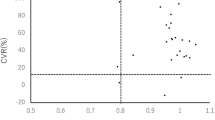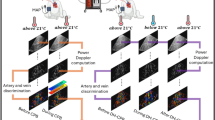Abstract
Background:
Premature infants are at risk of vascular neurologic insults. Hypotension and hypertension are considered injurious, but neither condition is defined with consensus. Cerebrovascular critical closing pressure (CrCP) is the arterial blood pressure (ABP) at which cerebral blood flow (CBF) ceases. CrCP may serve to define subject-specific low or high ABP. Our objective was to determine the ontogeny of CrCP.
Methods:
Premature infants (n = 179) with gestational age (GA) from 23–31 wk had recordings of ABP and middle cerebral artery flow velocity twice daily for 3 d and then daily for the duration of the first week of life. All infants received mechanical ventilation. CrCP was calculated using an impedance-model derivation with Doppler-based estimations of cerebrovascular resistance and compliance. The association between GA and CrCP was determined in a multivariate analysis.
Results:
The median (interquartile range) CrCP for the cohort was 22 mm Hg (19–25 mm Hg). CrCP increased significantly with GA (r = 0.6; slope = 1.4 mm Hg/wk gestation), an association that persisted with multivariate analysis (P < 0.0001).
Conclusion:
CrCP increased significantly from 23 to 31 wk gestation. The low CrCP observed in very premature infants may explain their ability to tolerate low ABP without global cerebral infarct or hemorrhage.
Similar content being viewed by others
Log in or create a free account to read this content
Gain free access to this article, as well as selected content from this journal and more on nature.com
or
References
Varsos GV, Budohoski KP, Kolias AG, et al. Relationship of vascular wall tension and autoregulation following traumatic brain injury. Neurocrit Care 2014;21:266–74.
Nichol J, Girling F, Jerrard W, Claxton EB, Burton AC. Fundamental instability of the small blood vessels and critical closing pressures in vascular beds. Am J Physiol 1951;164:330–44.
Jägersberg M, Schaller C, Boström J, Schatlo B, Kotowski M, Thees C. Simultaneous bedside assessment of global cerebral blood flow and effective cerebral perfusion pressure in patients with intracranial hypertension. Neurocrit Care 2010;12:225–33.
Varsos GV, Richards H, Kasprowicz M, et al. Critical closing pressure determined with a model of cerebrovascular impedance. J Cereb Blood Flow Metab 2013;33:235–43.
Panerai RB, Coughtrey H, Rennie JM, Evans DH. A model of the instantaneous pressure-velocity relationships of the neonatal cerebral circulation. Physiol Meas 1993;14:411–8.
Panerai RB, Kelsall AW, Rennie JM, Evans DH. Estimation of critical closing pressure in the cerebral circulation of newborns. Neuropediatrics 1995;26:168–73.
Report of a Joint Working Group of the British Association of Perinatal Medicine and the Research Unit of the Royal College of Physicians. Development of audit measures and guidelines for good practice in the management of neonatal respiratory distress syndrome. Arch Dis Child 1992;67:1221–7.
Dempsey EM, Barrington KJ. Treating hypotension in the preterm infant: when and with what: a critical and systematic review. J Perinatol 2007;27:469–78.
Batton B, Li L, Newman NS, et al.; Eunice Kennedy Shriver National Institute of Child Health & Human Development Neonatal Research Network. Use of antihypotensive therapies in extremely preterm infants. Pediatrics 2013;131:e1865–73.
Rhee CJ, Fraser CD 3rd, Kibler K, et al. The ontogeny of cerebrovascular pressure autoregulation in premature infants. J Perinatol 2014;34:926–31.
Dempsey EM, Al Hazzani F, Barrington KJ. Permissive hypotension in the extremely low birthweight infant with signs of good perfusion. Arch Dis Child Fetal Neonatal Ed 2009;94:F241–4.
Michel E, Zernikow B, von Twickel J, Hillebrand S, Jorch G. Critical closing pressure in preterm neonates: towards a comprehensive model of cerebral autoregulation. Neurol Res 1995;17:149–55.
Helou S, Koehler RC, Gleason CA, Jones MD Jr, Traystman RJ. Cerebrovascular autoregulation during fetal development in sheep. Am J Physiol 1994;266(3 Pt 2):H1069–74.
Szymonowicz W, Walker AM, Yu VY, Stewart ML, Cannata J, Cussen L. Regional cerebral blood flow after hemorrhagic hypotension in the preterm, near-term, and newborn lamb. Pediatr Res 1990;28:361–6.
Dewey RC, Pieper HP, Hunt WE. Experimental cerebral hemodynamics. Vasomotor tone, critical closing pressure, and vascular bed resistance. J Neurosurg 1974;41:597–606.
Panerai RB. The critical closing pressure of the cerebral circulation. Med Eng Phys 2003;25:621–32.
Aaslid R, Lash SR, Bardy GH, Gild WH, Newell DW. Dynamic pressure–flow velocity relationships in the human cerebral circulation. Stroke 2003;34:1645–9.
Soehle M, Czosnyka M, Pickard JD, Kirkpatrick PJ. Critical closing pressure in subarachnoid hemorrhage: effect of cerebral vasospasm and limitations of a transcranial Doppler-derived estimation. Stroke 2004;35:1393–8.
Bassan H, Gauvreau K, Newburger JW, et al. Identification of pressure passive cerebral perfusion and its mediators after infant cardiac surgery. Pediatr Res 2005;57:35–41.
Pellicer A, Valverde E, Gayá F, Quero J, Cabañas F. Postnatal adaptation of brain circulation in preterm infants. Pediatr Neurol 2001;24:103–9.
Mosca F, Bray M, Lattanzio M, Fumagalli M, Tosetto C. Comparative evaluation of the effects of indomethacin and ibuprofen on cerebral perfusion and oxygenation in preterm infants with patent ductus arteriosus. J Pediatr 1997;131:549–54.
Benders MJ, Hendrikse J, de Vries L, Groenendaal F, van Bel F. Doppler-assessed cerebral blood flow velocity in the neonate as estimator of global cerebral blood volume flow measured using phase-contrast magnetic resonance angiography. Neonatology 2013;103:21–6.
Batton B, Batton D, Riggs T. Blood pressure during the first 7 days in premature infants born at postmenstrual age 23 to 25 weeks. Am J Perinatol 2007;24:107–15.
Logan JW, Westra SJ, Allred EN, et al.; ELGAN Study investigators. Antecedents of perinatal cerebral white matter damage with and without intraventricular hemorrhage in very preterm newborns. Pediatr Neurol 2013;49:88–96.
Perlman JM, Risser R, Broyles RS. Bilateral cystic periventricular leukomalacia in the premature infant: associated risk factors. Pediatrics 1996;97(6 Pt 1):822–7.
Limperopoulos C, Bassan H, Kalish LA, et al. Current definitions of hypotension do not predict abnormal cranial ultrasound findings in preterm infants. Pediatrics 2007;120:966–77.
Kaiser JR, Gauss CH, Williams DK. Surfactant administration acutely affects cerebral and systemic hemodynamics and gas exchange in very-low-birth-weight infants. J Pediatr 2004;144:809–14.
Kaiser JR, Gauss CH, Williams DK. The effects of hypercapnia on cerebral autoregulation in ventilated very low birth weight infants. Pediatr Res 2005;58:931–5.
Kaiser JR, Gauss CH, Williams DK. Tracheal suctioning is associated with prolonged disturbances of cerebral hemodynamics in very low birth weight infants. J Perinatol 2008;28:34–41.
Kaiser JR, Gauss CH, Williams DK. The effects of closed tracheal suctioning plus volume guarantee on cerebral hemodynamics. J Perinatol 2011;31:671–6.
Lightburn MH, Gauss CH, Williams DK, Kaiser JR. Cerebral blood flow velocities in extremely low birth weight infants with hypotension and infants with normal blood pressure. J Pediatr 2009;154:824–8.
Kasprowicz M, Czosnyka M, Soehle M, et al. Vasospasm shortens cerebral arterial time constant. Neurocrit Care 2012;16:213–8.
Zeger SL, Liang KY. Longitudinal data analysis for discrete and continuous outcomes. Biometrics 1986;42:121–30.
Ratcliffe S, Shults J. GEEQBOX: A Matlab toolbox for generalized estimating equations and quasi-least squares. J Stat Softw 2008;25:1–14.
Acknowledgements
The technical assistance of Natalie C. Sikes and Melanie J. Mason and the support of the University of Arkansas for Medical Sciences neonatologists, NICU nurses, respiratory therapists, and ultrasound technicians are gratefully appreciated.
Author information
Authors and Affiliations
Corresponding author
PowerPoint slides
Rights and permissions
About this article
Cite this article
Rhee, C., Fraser, C., Kibler, K. et al. Ontogeny of cerebrovascular critical closing pressure. Pediatr Res 78, 71–75 (2015). https://doi.org/10.1038/pr.2015.67
Received:
Accepted:
Published:
Issue date:
DOI: https://doi.org/10.1038/pr.2015.67
This article is cited by
-
Observed and calculated cerebral critical closing pressure are highly correlated in preterm infants
Pediatric Research (2019)
-
Neonatal cerebrovascular autoregulation
Pediatric Research (2018)



